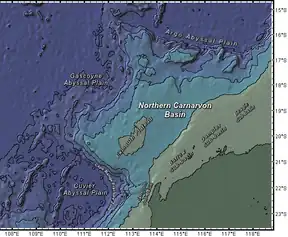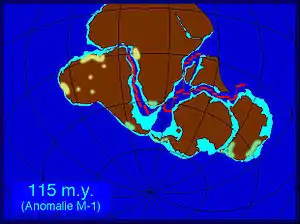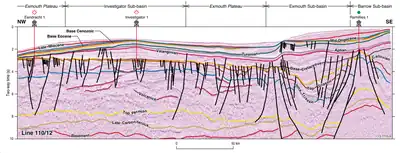Exmouth Plateau
The Exmouth Plateau is an elongate northeast striking extensional passive margin located in the Indian Ocean roughly 3,000 meters offshore from western and northwestern Western Australia.
| Exmouth Plateau | |
|---|---|
 Image of the Northern Carnarvon Basin and other outlying structure on the coast of the Northwest Australian Margin | |
| Type | Extensional Passive Margin |
| Location | |
| Coordinates | 19° 00'00" S, 114° 00'00" E |
| Region | Northwestern Australia |
| Country | Australia |
The plateau makes up the westernmost structural unit of the Northern Carnarvon Basin, which comprises the Exmouth, Barrow, Dampier, and Beagle Sub-basins, and the Rankin Platform.[1] The Exmouth Plateau was once a part of the northern shore of eastern of Gondwanaland until it broke away during Late Jurassic to Early Cretaceous, leaving behind the oceanic crust of the Argo, Cuvier, and Gascoyne abyssal plains that now surround the distal margins of Exmouth Plateau.[2]
Tectonic history

In the Late Jurassic, Gondwanaland begins to break apart creating Western Gondwana, which was composed of the South American and African continental land masses, and Eastern Gondwana. The Eastern Gondwanian continent was composed of Madagascar, Greater India, Antarctica, and Australia. During this period of time Australia shared its southern margin with Antarctica and the western margin (now the Exmouth Plateau) with Greater India.[3][4] The formation of the Exmouth's northern margin, the Argo Abyssal Plain, was not initiated until 155 million years ago when Australia broke apart from a continental fragment of the Burma plate that's present location is argued to be subsumed under Asia.[5] It wasn't until 20 million years later that the Greater Indian land mass broke from western Australia, forming the central and southern margins of the Exmouth Plateau now known as the Gascoyne and Cuvier Abyssal Plains.[4] As Australia continued to diverge away from the Antarctic land mass, it migrated in a northeastern direction and rotated counterclockwise to it present location, leaving the Exmouth Plateau along the continent's western margin.[2]
Late Triassic
In the begin of the late Triassic, high volumes of sediments accumulate off of the shoreline of western Australia to the northern extend of the Exmouth Plateau by the Mungaroo Deltas. The Carnian (237-228 Ma) to Norian (228-209 Ma) aged fluviodeltaic sediments deposited were siliciclastic claystones and sandstones, and detritus which would late make up the coals found in Mungaroo Formation. As extensional rifting between Greater Indian and the Australian continued, magmatic intrusion along the westernmost section of the Exmouth Plateau caused further rifting to the outer margins.[2][6] By the end of the Late Triassic (209-201 Ma) tectonic activity had relatively slowed down and less deltaic sediments were deposited compared to the Carnian and Norian. More marine sedimentary deposit such as carbonates are found during this time period.[7]
Early Jurassic
.png.webp)
During the early Jurassic, extension at the west Australian margin initiated simple shear mechanics creating a system of listric normal faults near the eastern region of the Exmouth Plateau.[8] These listric faults were a product from the development of a major low angle detachment fault between a sedimentary base of Permian-Triassic upper crust and the mid-crustal horizon.[9] As a result, brittle deformation and crustal thinning in the upper crust of the eastern Exmouth Plateau occurred, while in the west, the lower crystalline crust and lithosphere experienced shear stress and thinning.[8] The formation of the fault system closer to the coast caused the initial development of the Exmouth, Barrow, and Dampier sub-basins of the Northern Carnarvon Basin.[1] Carbonate marine sediment, primarily marls, continued to be deposited at this time on the central and western portions of the plateau. Closer to the shoreline siliciclastic mud and silt were deposited from marine and deltaic environments.[2]
Middle to late Jurassic

As extension continued in the mid to late Jurassic, multiple pull-apart basins and oblique right-lateral strike-slip faulting in the eastern margin of the Exmouth Plateau continued to dominate. The simple shear stress of the Exmouth detachment fault between the base of the upper crust, and the lower crust had been reduced in the east plateau. This reduction in simple shear was in part caused by the deformation that developed series negative flower structures and half-graben systems in the west plateau. By this time, the lithospheric thinning that had been initiated during the early Jurassic was now considerably thinner. At this period, a magmatic intrusion between the lower crystalline crest and the lithosphere been introduce, underplating this region.[6][8]
Early Cretaceous
In Early Cretaceous, pure shear deformation at the ocean-continental boundary completed the final continental breakup and sea-floor spreading. By this time the overall structural morphology of the Exmouth Plateau had taken shape, aside from the post-breakup subsidence that occurred afterward from the Late Cretaceous to present day.[8] Activity at the eastern Exmouth Plateau's detachment system had likely ceased which is reason for the completion of the plateau's morphology.[7]
Sequence stratigraphy
Locker Shale and Mungaroo Formation
| Period | Epoch | Age | Formation |
|---|---|---|---|
| Triassic | Late | Rhaetian (209-201 Ma) |
Brigadier Formation |
| Norian (228-209 Ma) |
Mungaroo Formation | ||
| Carnian (237-228 Ma) | |||
| Middle | Ladinian (241-237 Ma) | ||
| Anisian (247-241 Ma) |
Locker Shale | ||
| Early | Olenekian (250-247 Ma) | ||
| Induan (252-250 Ma) |
The Locker Shale and Mungaroo formation are associated with the syn-rift and post-rift sequences of the Permian extension that occurred just prior to the late Triassic extension event across the northwestern margin of Australia. Lying atop unconformable unit of Paleozoic sediments, the Locker Shale is composed of marine sediments deposited in a transgressional environment during the Late Permian extension.[10] These marine sediments were deposited at the base of the Late Triassic and continued up until the end of Anisian age when it transitioned in the Mungaroo Formation. The Mungaroo Formation is an intricate fluvial environment of meandering and braided stream deposits laid down in the Ladinian (~241 Mya) to Norian ages (~209 Mya) during the pre-rift active margin of the Northwestern Australian Shelf.[11] It is one of the thickest formations in the region and becomes progressively thicker (approximately 3,000 m thick) in the distal portions of the Northern Carnarvon Basin furthest offshore.[12] One of the primary gas source for the Exmouth Plateau and Northern Carnarvon Basin, the Mungaroo Formation contains thick successions of siltstone, sandstone, and coal.[13]
Brigadier Formation
The Mungaroo Formation is capped by thin transgressive sequence of shallow marine claystone and limestone called the Brigadier Formation.[1] This is a much thinner formation than the Mungaroo laid down only for a short period of time between the beginning of the Rhaetian to the Early Hettangian. Due to the thickness of fluvial deltaic deposits from the Mungaroo Formation, the transgressional sequence of the Brigadier Formation is correlated with the subsidence of sub-basins across region during the Middle and Late Triassic.[14]
Dingo Claystones
| Period | Epoch | Age | Lithologies |
|---|---|---|---|
| Jurassic | Late | Tithonian (145-152 Ma) | |
| Kimmeridgian (157-152 Ma) | Upper Dingo Claystone | ||
| Oxfordian (164-157 Ma) | |||
| Callovian (166-164 Ma) | |||
| Middle | Bathonian (168-166 Ma) | Lower Dingo Claystone | |
| Bajocian (170-168 Ma) | |||
| Aalenian (174-170 Ma) | |||
| Early | Toarcian (183-174 Ma) | ||
| Pliensbachian (191-183 Ma) | |||
| Sinemurian (199-191 Ma) | |||
| Hettangian (201-199 Ma) | |||
The distribution of sediment packages throughout the Northern Carnarvon Basin and Exmouth Plateau varies with location during the Jurassic. By the Pliensbachian, the general beginning structure of the Northern Carnarvon Basin was formed, creating the Exmouth, Barrow, and Dampier sub-basins along the proximal end of the northwestern Australian margin.[1] Rapid subsidence of the Northern Carnarvon sub-basins ensued the deposition of the Dingo Claystones.[14] These Claystones are thick marine shale deposits separated into two sequence, the Upper and Lower Dingo Claystones.[1] The Lower Dingo sequence cannot be found in the Exmouth Plateau, because deposition During the Early to Middle Jurassic was restricted to sediments filling in the empty troughs of the Northern Carnarvon sub-basins.[15] As deposition continued through the Middle and Late Jurassic, the troughs of sub-basins filled allowing more of the Dingo sediment overflow into the distal margins of the region.[7] This depositional sequence characterizes the Upper Dingo Claystones, which are found as thick proximal sequences in the Northern Carnarvon sub-basins and thinner distal sequences in the Exmouth Plateau.[15]
Barrow Group
| Period | Epoch | Age | Formation |
|---|---|---|---|
| Cretaceous | Late | Maastrichtian (72.1-66.0 Ma) | Miria Formation |
| Campanian (83.6-72.1 Ma) | Toolonga Calcilutite | ||
| Santonian (86.3-83.6 Ma) | |||
| Coniacian (89.8-86.3 Ma) | |||
| Turonian (93.9-89.8 Ma) | |||
| Cenomanian (100-93.9 Ma) | Winning Group | ||
| Early | Albian (100-113 Ma) | ||
| Aptian (126-113 Ma) | |||
| Barremian (131-126 Ma) | |||
| Hauterivian (134-131 Ma) | |||
| Valanginian (139-134 Ma) | Barrow Group | ||
| Berriasian (145-139 Ma) | |||
During the late Tithonian to early Valanginian there were major changes in depositional patterns, specifically associated with the Barrow Group.[10] At this period of time there was large uplift of the Cape Range Fracture Zone that provided sediments from the Barrow Delta prograde northward past Barrow Island and across the Exmouth Plateau. The sediments of the Barrow Group are composed of interbedded shale and fluvial-deltiac sands that were extensively deposited into Exmouth and Barrow sub-basins.[16]
Winning Group
Eventually, deposition of the Barrow Delta's sediment ceased during the early or middle Valanginian due to the continental break up at the southern margin of the Exmouth Plateau.[17] This followed seafloor spreading at the Gascoyne and Cuvier Abyssal Plains and erosion at the surface of the Exmouth, Dampier and Barrow sub-basins and an unconformity at the top of the early to middle Valanginian.[1] By the middle to late Valanginian and through the Cretaceous major transgression occurred with deposit of the Winning Group atop the Valanginian unconformity.[14] The Winning Group consists of Muderong Shale, Windalia Radiolarite, and Gearle Siltstone.[1] The Muderong Shale is actually considered a siltstone and was deposited in a low energy, offshore-marine environment. The deposition of these sediments makes a good seal for gas buildups in the Exmouth Plateau and the surrounding sub-basins of the Northern Carnvon Basin.[18] The Windalia Radiolarite are primarily carbonate marine deposits commonly containing poorly preserved radiolarians and forminiferas.[18] The Gearle Siltstone is a low-energy, offshore-marine deposit in a period when input of the terrigenous sediments to the offshore was low minimal.[19]
References
- "Regional Geology of the Northern Carnarvon Basin" (PDF). Geoscience Australia. Archived from the original (PDF) on 9 March 2015. Retrieved 18 February 2015.
- Exon, N.F.; Haq, B.U.; Rad, U. von (1992). "Exmouth Plateau revisited: scientific drilling and geological framework" (PDF). Proceedings of the Ocean Drilling Program. 122: 3–20.
- Görür, N.; Sengör, A.M.C. (1992). "Paleogeography and tectonic evolution of the eastern Tethysides: implications for the northwest Australian margin breakup history". Proceedings of Ocean Drilling Program, Scientific Results. 122: 83–106.
- Fullerton, Lawrence G.; Sager, William W.; Handschumacher, David W. (1989). "Late Jurassic-Early Cretaceous evolution of the eastern Indian Ocean adjacent to northwest Australia". Journal of Geophysical Research. 94 (B3): 2937–2953. Bibcode:1989JGR....94.2937F. doi:10.1029/JB094iB03p02937.
- Dewey, J.F. (1988). "Lithospheric stress, deformation and tectonic cycles: the disruption of Pangea and the closure of Tethys". Geology Society of London Special Publications. 37 (1): 23–40. Bibcode:1988GSLSP..37...23D. doi:10.1144/GSL.SP.1988.037.01.03. S2CID 129032327.
- Lorenzo, Juan M.; Mutter, John C.; Larson, Roger L. (1991). "Development of the continent-ocean transform boundary of the southern Exmouth Plateau". Geology. 19 (8): 843–846. Bibcode:1991Geo....19..843L. doi:10.1130/0091-7613(1991)019<0843:DOTCOT>2.3.CO;2.
- Stagg, H.M.J.; Alcock, M.B.; Bernardel, G.; Moore, A.M.G.; Symonds, P.A.; Exon, N.F. (2013) [2004]. Geological framework of the Outer Exmouth Plateau and adjacent ocean basins. Geoscience Australia Record. ISBN 978-1920871086.
- Mutter, John C; Larson, Roger L. (1989). "Extension of the Exmouth Plateau, offshore northwestern Australia: Deep seismic reflection/refraction evidence for simple and pure shear mechanisms". Geology. 17 (1): 15–18. Bibcode:1989Geo....17...15M. doi:10.1130/0091-7613(1989)017<0015:EOTEPO>2.3.CO;2.
- Wernicke, B. (1981). "Low-angle normal faults in the Basin and Range province". Nature. 291: 645–648. doi:10.1038/291645a0. S2CID 4269466.
- Kopsen, E.; McGann, G. (1985). "A review of the hydrocarbon habitat of the eastern and central Barrow-Dampier sub-basin, Western Australia". Apea J. 25: 154–176.
- Vos, R.G.; McHattie, C.M. (August 17–20, 1981). "Upper Triassic depositional environments, Central Exmouth Plateau (permit WA-84-P) Northwestern Australia". Paper Presented at 5th Australian Geological Convention.
- Cockbain, A.E. (1983). "The North West Shelf". Apea J. 29: 529–545.
- Barber, P. (1988). "The Exmouth Plateau deepwater frontier: a case study" (The North West Shelf, Australia: Proceedings of the Petroleum Exploration Society of Australia Symposium, Perth): 173–187.
{{cite journal}}: Cite journal requires|journal=(help) - Driscoll, Neal W.; Karner, Garry d. (March 10, 1998). "Lower crustal extension across the Northern Carnarvon basin, Australia: Evidence for an eastward dipping detachment". Journal of Geophysical Research. 103 (B3): 4975–4991. Bibcode:1998JGR...103.4975D. doi:10.1029/97jb03295.
- Colwell, J.B.; Röhl, U.; von Rad, U.; Kristan-Tollmann, E. (1994). "Mesozoic sedimentary and volcaniclastic rocks dredged from the northern Exmouth Plateau and Rowley Terrace, offshore northwest Australia". Journal of Australian Geology and Geophysics. 15 (1): 11–42. Bibcode:1994JAuGG..15...11C.
- Boyd, R.; Williamson, P.; Haq, B. (1992). "Seismic stratigraphy and passive margin evolution of the Southern Exmouth Plateau". Proceedings of the Ocean Drilling Program, Scientific Results. 122: 39–59.
- Hocking, R.M. (1990). "Carnarvon Basin: Geology and Mineral Resources of Western Australia". Western Australia Geological Survey: 457–495.
- Hocking, R.M.; Moors, H.T.; van de Graaff, W.J.E. (1987). "Geology of the Carnarvon Basin Western Australia". Geological Survey of Western Australia.
- Apthorpe, M.C. (1979). "Depositional history of the upper Cretaceous of the Northwest Shelf, based on Foraminera". Australian Petrolium Exploration Association Journal. 19 (1): 74–89.